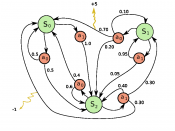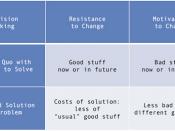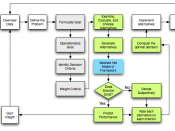"Decision making is the cognitive process leading to the selection of a course of action among alternatives. Every decision-making process produces a final choice called a decision. It can be an action or an opinion. It begins when we need to do something but we do not know what. Therefore, decision-making is a reasoning process which can be rational or irrational, and can be based on explicit assumptions or tacit assumptions." (Wikipedia pg 1). The previous few sentences give the definition of decision making according to the Wikepedia website. In making decisions, most people use models whether they realize it or not. The purpose of this paper is to analyze the rational decision-making model and give an example of how this model can be used.
According to Ryan K. Lahti, we use four basic decision-making models in today's business world (1996 pg 1). These four models are the rational, political, process, and garbage can models.
As can be expected, each of the four models has quite diverse advantages as well as disadvantages. Though each model can be used in a variety of situations, they do each apply more accurately and easily in certain given situations. I have chosen to analyze one of the most popular models in this paper, the decision-making model.
The rational decision-making model is based on the current economical aspects of decision making. It is also based on a scientific, methodical approach to decision making. Thomas S. Bateman and Scott A. Snell, in Management: The New Competitive Landscape, explain that by following the six given steps in the rational decision-making model individuals are more easily able to make clear and precise decisions (2004 pg 70-71). The six steps that they spoke of are as follows.
1. Identify and diagnose the problem.
2. Generate alternative solutions.
3. Evaluate alternatives.
4. Make the choice.
5. Implement the decision.
6. Evaluate the decision.
We will now begin to analyze this decision-making models step for step and show its use within an organization.
The first step in the rational decision-making model is to identify and diagnose the problem. In doing this, a person or a group of people is basically trying to understand exactly what type of problem they may have. They are also looking at the most obvious way in which to resolve the problem. The second step is to generate alternative solutions to the problem. In doing this, a person is trying to come up with a set of alternative solutions aside from the original solution that was derived. Step three calls for an evaluation of the alternative solutions. In this step a person will examine all of the alternative solutions to see which solution best fits the situation. In step four a decision is made. The person or group will decide which of the compiled solutions explains the best course of action for the problem. In step five, the decision is implemented. This is when the decided course of action is put into effect to try and resolve the given problem. Finally, step six calls for an evaluation of the decision that as been implemented. This is the step that will let everyone know if the decision was correct. If the decision does not turn out to be the best course of action, the person or persons will begin the process anew.
I have seen this model of decision making used on various occasions. In fact it is used on such a regular basis that most people do not even realize that they are doing it. We recently ran into some problems at the plant in which I work that required some critical decision making. Our plant consists of a steady flow of materials in liquid form. For this to work properly we must keep a vigilant watch over the liquid volume levels in certain areas of the plant. In this particular situation, we were having an extremely difficult time keeping our volumes at the correct levels for the plant to operate smoothly. All told, we were trying to accomplish several goals within a given period of time that required us to run our operation at maximum output. We found that we were not going to be able to accomplish our goals and still have the plant running if we kept going at the current pace. Presto, we had Identified our problem and we ad a general diagnosis.
Upon learning of the situation, our boss called a production meeting. We came together to brainstorm the problem as a team. Several ideas were placed on the proverbial table to be looked at. As each idea was given, everyone in the meeting had a chance to give his or her input on it. As a result we came up with a solution that involved variables of several different alternatives that were given during the meeting. All of a sudden we had made it through the second, third, and fourth steps in our model. After the meeting, we each returned to our designated areas with a concise plan of what was to happen. The plan was then implemented and we each did our jobs to the exact parameters called for in the meeting. The time had come to wait and see if we were going to be correct. After a few hours, our volumes had started heading to more normal levels and we were steadily gaining on our goals. We had completed the rational decision-making model and had been successful.
As one can see, the rational decision-making model is one that can be used in a variety of situations. There are alternative models available to those who do not wish to use the rational model. However, I hope you can see from this paper that this model is simple in its design and very easy to use. It can be used individually or by a large group of people. It can also be used by simple laymen as well as corporate giants. I have shown how a group of chemical operators went through this model and made not only a rational decision based on the facts but the correct decision for the situation. I hope this model serves its purpose for all who use it as well as for me in future endeavors.
Works Cited:
Bateman, T.S.; Snell, S.A. (2004). Management: The New Competitive Landscape (6th edition). New York: McGraw-Hill
Lahti, R.K. (1996). Group Decision Making within Organizations: Can Models Help? Retrieved June 4, 2006, from http://workteams.unt.edu/reports/lahti.htm
Decision Making - Wikipedia, the free encyclopedia. Retrieved June 4, 2006, from http://en.wikipedia.org/wiki/Decision_making


